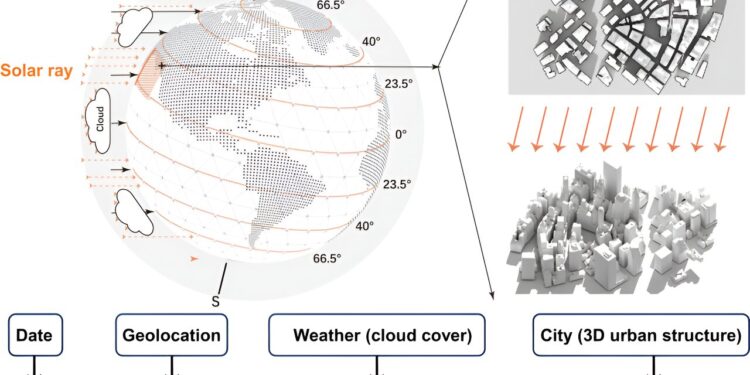Sunlight in 3D Cities: Shows how date, location, weather, and city structure affect sunlight using cloud cover and 3D data. Credit: Cities-Nature (2024). DOI: 10.1038/s44284-024-00120-x
Sunlight plays a crucial role in public health, affecting vitamin D synthesis and psychological well-being. Insufficient exposure to sunlight is associated with various adverse health effects, such as cardiovascular disease, metabolic syndrome, depression, and mental disorders.
Ideal, or reference, sunshine represents the maximum amount of sunshine a region would receive each year in the absence of cloud cover or urban structures, approximately 4,460 hours. Urban development, particularly skyscrapers, can block natural sunlight, reducing exposure by up to 90% in high-rise cities such as Hong Kong.
This lack of sunlight contributes to health problems such as vitamin D deficiency and myopia, particularly in children and the elderly. The rapid increase in tall building construction since the 1970s has exacerbated the problem, highlighting the need for urban planning that ensures adequate sunlight for residents.
Recently, researchers from the University of Hong Kong developed a framework for assessing sunshine duration in cities, revealing a substantial reduction in available sunlight due to cloud cover and three-dimensional urban structures. The results were published in Cities-Naturehighlighting the imperative of integrated urban planning approaches that emphasize sufficient access to sunlight.
Existing studies often neglect the details of how 3D urban structures and cloud cover together affect sunlight availability.
The research team synthesized a suite of remote sensing data and process-based models of built-up urban areas, cloud observations, urban structure parameters, and climate conditions—representing a “digital twin” of urban environments—to assess sunlight dynamics in 1,353 U.S. cities for the year 2020.
Applying this framework to 1,353 U.S. cities, the results reveal a significant decrease of 2,896 h (121 days) in available sunshine for 2020, with cloud cover accounting for 2,448 h (102 days) and urban structures contributing to a loss of 448 h (19 days).
Annual sunshine maps for 1,353 U.S. cities in 2020: a) Day length: duration of sunshine from sunrise to sunset. b) Natural sunshine: actual sunshine due to cloud cover. c) Urban sunshine: sunshine over built-up areas. d) Sunshine reduction in built-up areas: difference between natural and urban sunshine due to 3D urban structures. Credit: Cities-Nature (2024). DOI: 10.1038/s44284-024-00120-x
Nationwide studies show that cloud cover and urban structures significantly reduce annual sunshine hours. Cloud cover alone is responsible for a 55% reduction in sunshine, which translates to 102 days of sunshine lost per year. Urban structures contribute an additional 19 days of sunshine per year.
The effects of cloud cover are particularly pronounced in the Northeast (such as Maine and New York) and Northwest (such as Washington), where annual sunshine hours decrease from 4,460 to 1,500. Additionally, the impacts of urban shading show distinct geographic variations, with stronger trends in coastal cities.
Professor Bin Chen, the project’s principal investigator and Assistant Professor in HKU’s Division of Landscape Architecture, said: “This study builds on our previous research published in 2023 in Natureon the optimization of urban shading using digital twins, and aimed at studying the interaction between nature and three-dimensional urban structures that limit the availability of sunlight.
Professor Chen highlighted two important contributions of this study and said: “The conceptual model developed allows us to account for various factors including latitude, cloud cover, seasonal variations and urban structures with respect to sunshine duration.
“This is essential to capture the complex interplay between geographic, climatic and structural elements that affect sun exposure in densely built urban areas. Another key point is that the cumulative impact of these factors leads to a total annual reduction of 2,896 hours of sunshine, or the equivalent of 121 days.”
“With increasing cloud cover and urbanization, sunlight loss is likely to worsen,” Professor Chen noted, noting that the study highlights the urgent need for interdisciplinary urban planning strategies that prioritize adequate access to natural sunlight.
“Rapid urbanisation and the increase in the number of tall buildings have profound implications for energy management and public health. The loss of sunlight could exacerbate energy demand and increase carbon emissions, especially in cold regions and seasons. We need local regulations to ensure equitable access to sunlight in high-density areas,” said Professor Chen Lin, Chair Professor of Finance and Associate Vice-President at HKU.
More information:
Shengbiao Wu et al, Interaction of cloud cover and 3D urban structures reduces human access to sunlight, Cities-Nature (2024). DOI: 10.1038/s44284-024-00120-x
Provided by the University of Hong Kong
Quote:Cloud cover and urban structures significantly reduce sunshine in cities (2024, September 25) retrieved September 25, 2024 from
This document is subject to copyright. Apart from any fair dealing for the purpose of private study or research, no part may be reproduced without written permission. The content is provided for informational purposes only.



